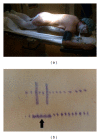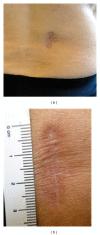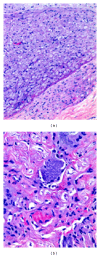Minimally invasive resection of an extradural far lateral lumbar schwannoma with zygapophyseal joint sparing: surgical nuances and literature review
- PMID: 25328530
- PMCID: PMC4189855
- DOI: 10.1155/2014/739862
Minimally invasive resection of an extradural far lateral lumbar schwannoma with zygapophyseal joint sparing: surgical nuances and literature review
Abstract
Introduction. Spinal schwannomas are benign nerve sheath tumors. Completely extradural schwannomas of the lumbar spine are extremely rare lesions, accounting for only 0,7-4,2% of all spinal NSTs. Standard open approaches have been used to treat these tumors, requiring extensive muscle dissection, laminectomy, radical foraminotomy, and facetectomy. In this paper the authors present the case of a minimally invasive resection of a completely extradural schwannoma. Operative technique literature review is presented. Material & Methods. A 50-year-old woman presented with progressive complains of chronic right leg pain and paresthesia. The magnetic resonance imaging revealed a giant well-encapsulated dumbbell-shaped extradural lesion at the L3-L4 level. The patient underwent a minimally invasive gross total resection of the tumor using a tubular expandable retractor system. Results. The patient had complete resolution of radiculopathy in the immediate postoperative period and she was discharged home, neurologically intact, on the second postoperative day. Postoperative MRI demonstrated no evidence of residual tumor. At latest follow-up (18 months) the patient remains asymptomatic. Conclusion. Although challenging, this minimally invasive procedure is safe and effective, being an appropriate alternative, with many potential advantages, to the open approach.
Figures










Similar articles
-
Minimally invasive resection of extradural dumbbell tumors of thoracic spine: surgical techniques and literature review.Eur Spine J. 2016 Dec;25(12):4108-4115. doi: 10.1007/s00586-016-4677-z. Epub 2016 Jul 1. Eur Spine J. 2016. PMID: 27371333 Review.
-
Minimally invasive removal of a giant extradural lumbar foraminal schwannoma.Surg Neurol Int. 2011;2:186. doi: 10.4103/2152-7806.91141. Epub 2011 Dec 26. Surg Neurol Int. 2011. PMID: 22368787 Free PMC article.
-
Minimally invasive removal of thoracic and lumbar spinal tumors using a nonexpandable tubular retractor.J Neurosurg Spine. 2013 Dec;19(6):708-15. doi: 10.3171/2013.9.SPINE121061. Epub 2013 Oct 18. J Neurosurg Spine. 2013. PMID: 24138063 Review.
-
Giant Lumbar Dumbbell Extradural Schwannoma in a Child.Asian J Neurosurg. 2019 Apr-Jun;14(2):535-537. doi: 10.4103/ajns.AJNS_132_18. Asian J Neurosurg. 2019. PMID: 31143276 Free PMC article.
-
Giant Dumbbell-Shaped Thoracic Schwannoma in an Elderly Patient Resected Through a Single-Stage Combined Laminectomy and Video-Assisted Thoracoscopy: Surgical Strategy and Technical Nuances.World Neurosurg. 2018 Nov;119:155-162. doi: 10.1016/j.wneu.2018.07.238. Epub 2018 Aug 6. World Neurosurg. 2018. PMID: 30092472
Cited by
-
Microscopic Minimal Invasive Resection of Spinal Tumor with Tubular Retractor System: Case Studies of 70 Patients with Literature Review.Asian J Neurosurg. 2025 Apr 3;20(3):491-497. doi: 10.1055/s-0045-1806866. eCollection 2025 Sep. Asian J Neurosurg. 2025. PMID: 40852071 Free PMC article.
-
Minimally Invasive Direct Lateral Transpsoas Approach for the Resection of a Lumbar Plexus Schwannoma: Technique Report.Surg J (N Y). 2016 Aug 6;2(3):e66-e69. doi: 10.1055/s-0036-1587692. eCollection 2016 Jul. Surg J (N Y). 2016. PMID: 28824993 Free PMC article.
-
The Optimal Surgical Approach to Intradural Spinal Tumors: Laminectomy or Hemilaminectomy?Cureus. 2020 Feb 23;12(2):e7084. doi: 10.7759/cureus.7084. Cureus. 2020. PMID: 32226685 Free PMC article.
-
Minimally invasive tubular removal of spinal schwannoma and neurofibroma - a case series of 49 patients and review of the literature.Neurosurg Rev. 2024 Aug 10;47(1):418. doi: 10.1007/s10143-024-02656-x. Neurosurg Rev. 2024. PMID: 39123090 Free PMC article. Review.
-
Minimally invasive resection of extradural dumbbell tumors of thoracic spine: surgical techniques and literature review.Eur Spine J. 2016 Dec;25(12):4108-4115. doi: 10.1007/s00586-016-4677-z. Epub 2016 Jul 1. Eur Spine J. 2016. PMID: 27371333 Review.
References
-
- Nittner K, Vinken PH, Bruyn GW, editors. Handbook of Clinical Neurology. New York, NY, USA: North Holland, Amsterdam, The Netherlands; Elsevier; 1976. Spinal meningiomas , neuromas and neurofibromas, and hourglass tumors; pp. 177–322.
-
- Jinnai T, Hoshimaru M, Koyama T. Clinical characteristics of spinal nerve sheath tumors: analysis of 149 cases. Neurosurgery. 2005;56(3):510–515. - PubMed
-
- Greenberg MS. Handbook of Neurosurgery. Thieme; 2010. Spinal schwannomas; pp. 734–736.
-
- Celli P, Trillò G, Ferrante L. Spinal extradural schwannoma. Journal of Neurosurgery Spine. 2005;2(4):447–456. - PubMed
LinkOut - more resources
Full Text Sources
Other Literature Sources

